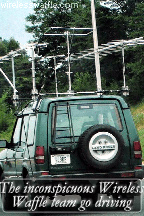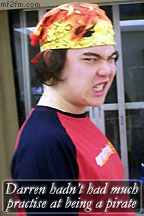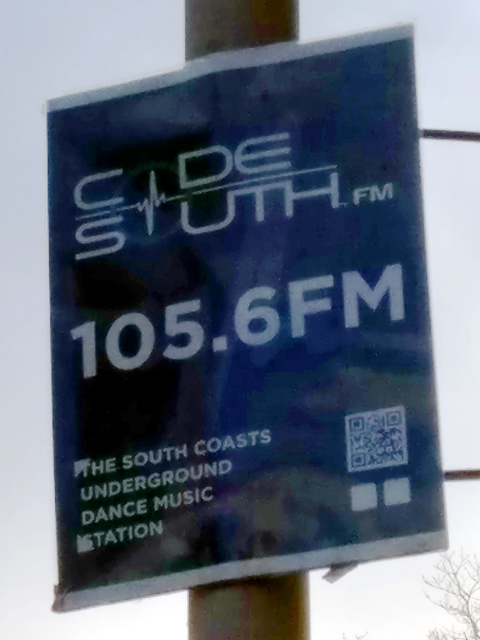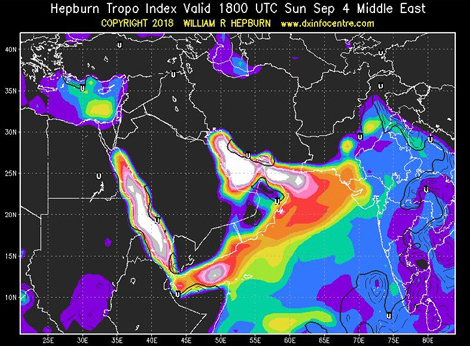Car journeys can be long and laborious, and, in many cases, just plain boring. However, for the avid radio DXer, they can also be an excellent opportunity to try and receive radio signals from far afield. This is especially the case for journeys that either run close to the sea (where tropospheric propagation may enhance distance reception), or over hills and mountains (where the elevated position of the receiver may increase line-of-sight). Further, many car radios are both sensitive and selective, making them great receivers to eke out weak signals.
 On a recent car journey across the UK, for example, Wireless Waffle was able to add Omroep Zeeland to the FM DX Logbook, despite radio reception conditions being what can only be described as 'as flat as the mountains of the Netherlands'. We thought, though, that it might be interesting to share our experiences of how a car journey can be turned into a DX-pedition (as they are known), safely and easily, as well as some very intriguing and unusual results.
On a recent car journey across the UK, for example, Wireless Waffle was able to add Omroep Zeeland to the FM DX Logbook, despite radio reception conditions being what can only be described as 'as flat as the mountains of the Netherlands'. We thought, though, that it might be interesting to share our experiences of how a car journey can be turned into a DX-pedition (as they are known), safely and easily, as well as some very intriguing and unusual results.
Playing around with your car radio whilst driving is probably a bad idea, and not that safe either, so the best thing to do is to tune to just a single frequency and see what crops up. How do you choose which frequency to tune to? In the example of Omroep Zeeland above, it was 87.9 MHz. This frequency is not used by any FM transmitters in the UK (check the list at frequencyfinder.org.uk) and as such, any transmissions you do hear are either going to be pirate radio stations, or iTrip type devices (more of which later). Many of the frequencies at the bottom end of the FM band including 87.8 and 87.6 are also good candidates but there may be others, depending on which area you live in (105.0 and 105.1 are also relatively ununsed in much of the UK).
 On these 'empty' frequencies what you will hear most of the time is 'ssssssshhh' (a.k.a. white noise). If there are others travelling with you on the journey, this can be extremely annoying, so this is a sport best played alone. However, from time to time, this noise will be punctuated by snippets of speech or music (which for a non radio funster, can be even more annoying than the noise).
On these 'empty' frequencies what you will hear most of the time is 'ssssssshhh' (a.k.a. white noise). If there are others travelling with you on the journey, this can be extremely annoying, so this is a sport best played alone. However, from time to time, this noise will be punctuated by snippets of speech or music (which for a non radio funster, can be even more annoying than the noise).
If you get enough speech or music to be able to identify the station, or (on occasion) get a signal for long enough, and strong enough, for RDS to appear, bingo, you've just landed yourself a DX catch. Even catching the language of the station and the style of programming may, in some cases, be sufficient to lead to an identification, especially if there are only a few stations in that language on a given frequency.
This is how Omroep Zeeland was identified. The language heard was clearly dutch, and it was a speech based program with occasional oldies music. According to fmscan.org, the following FM stations are within tropospheric range on a 'flat' band (i.e. a few 100 km at most), operate on 87.9 MHz, and are in the dutch language: There are no dutch speaking stations in Belgium on 87.9 and no other countries that speak dutch! Omroep Zeeland is a speech and oldies style station, where as Radio 10 is a music based station and although it plays oldies, it has far less speech content. Thus, identification of the snippets heard is relatively straightforward.
There are no dutch speaking stations in Belgium on 87.9 and no other countries that speak dutch! Omroep Zeeland is a speech and oldies style station, where as Radio 10 is a music based station and although it plays oldies, it has far less speech content. Thus, identification of the snippets heard is relatively straightforward.
One thing that did crop up whilst driving around listening to 87.9 and 87.5, was the number of strong signals that popped up with a strange variety of content from stories being read, to asian music and hip-hop. Whilst it would be easy to dismiss these as pirate radio stations, the fact that they appeared and disappeared relatively quickly tends to suggest that they were, in fact, 'iTrip' type transmitters connected to people's mobile phones, to allow music to be played on their car radios. These two frequencies are obvious choices for such devices given that they are not used for (legal) broadcasting in the UK.
An additional fun game that you can therefore give a go, is trying to work out which car driver is listening to which material. Who is the hip-hop fan, and who is listening to the x-rated audio book? Give 87.5 a try for this as it's repleat with lots of these iTrip type devices. I know what you are up to EK59 ESX!
 On a recent car journey across the UK, for example, Wireless Waffle was able to add Omroep Zeeland to the FM DX Logbook, despite radio reception conditions being what can only be described as 'as flat as the mountains of the Netherlands'. We thought, though, that it might be interesting to share our experiences of how a car journey can be turned into a DX-pedition (as they are known), safely and easily, as well as some very intriguing and unusual results.
On a recent car journey across the UK, for example, Wireless Waffle was able to add Omroep Zeeland to the FM DX Logbook, despite radio reception conditions being what can only be described as 'as flat as the mountains of the Netherlands'. We thought, though, that it might be interesting to share our experiences of how a car journey can be turned into a DX-pedition (as they are known), safely and easily, as well as some very intriguing and unusual results.Playing around with your car radio whilst driving is probably a bad idea, and not that safe either, so the best thing to do is to tune to just a single frequency and see what crops up. How do you choose which frequency to tune to? In the example of Omroep Zeeland above, it was 87.9 MHz. This frequency is not used by any FM transmitters in the UK (check the list at frequencyfinder.org.uk) and as such, any transmissions you do hear are either going to be pirate radio stations, or iTrip type devices (more of which later). Many of the frequencies at the bottom end of the FM band including 87.8 and 87.6 are also good candidates but there may be others, depending on which area you live in (105.0 and 105.1 are also relatively ununsed in much of the UK).
 On these 'empty' frequencies what you will hear most of the time is 'ssssssshhh' (a.k.a. white noise). If there are others travelling with you on the journey, this can be extremely annoying, so this is a sport best played alone. However, from time to time, this noise will be punctuated by snippets of speech or music (which for a non radio funster, can be even more annoying than the noise).
On these 'empty' frequencies what you will hear most of the time is 'ssssssshhh' (a.k.a. white noise). If there are others travelling with you on the journey, this can be extremely annoying, so this is a sport best played alone. However, from time to time, this noise will be punctuated by snippets of speech or music (which for a non radio funster, can be even more annoying than the noise). If you get enough speech or music to be able to identify the station, or (on occasion) get a signal for long enough, and strong enough, for RDS to appear, bingo, you've just landed yourself a DX catch. Even catching the language of the station and the style of programming may, in some cases, be sufficient to lead to an identification, especially if there are only a few stations in that language on a given frequency.
This is how Omroep Zeeland was identified. The language heard was clearly dutch, and it was a speech based program with occasional oldies music. According to fmscan.org, the following FM stations are within tropospheric range on a 'flat' band (i.e. a few 100 km at most), operate on 87.9 MHz, and are in the dutch language:
- Omrope Zeeland, transmitter site: Goes, transmitter power: 15kW
- Radio 10, transmitter site: Vught, transmitter power: 7.9 kW
 There are no dutch speaking stations in Belgium on 87.9 and no other countries that speak dutch! Omroep Zeeland is a speech and oldies style station, where as Radio 10 is a music based station and although it plays oldies, it has far less speech content. Thus, identification of the snippets heard is relatively straightforward.
There are no dutch speaking stations in Belgium on 87.9 and no other countries that speak dutch! Omroep Zeeland is a speech and oldies style station, where as Radio 10 is a music based station and although it plays oldies, it has far less speech content. Thus, identification of the snippets heard is relatively straightforward.One thing that did crop up whilst driving around listening to 87.9 and 87.5, was the number of strong signals that popped up with a strange variety of content from stories being read, to asian music and hip-hop. Whilst it would be easy to dismiss these as pirate radio stations, the fact that they appeared and disappeared relatively quickly tends to suggest that they were, in fact, 'iTrip' type transmitters connected to people's mobile phones, to allow music to be played on their car radios. These two frequencies are obvious choices for such devices given that they are not used for (legal) broadcasting in the UK.
An additional fun game that you can therefore give a go, is trying to work out which car driver is listening to which material. Who is the hip-hop fan, and who is listening to the x-rated audio book? Give 87.5 a try for this as it's repleat with lots of these iTrip type devices. I know what you are up to EK59 ESX!
2 comments
( 1301 views )
| permalink
| 



 ( 3.2 / 80947 )
( 3.2 / 80947 )




 ( 3.2 / 80947 )
( 3.2 / 80947 )
 Back in 2008, Wireless Waffle discussed the fact that the licensing of new community radio stations by Ofcom had forced many pirate radio stations to change frequency and in some cases to move to using two (or more) frequencies simultaneously in order to provide wide area coverage without treading on the toes of officially licensed stations.
Back in 2008, Wireless Waffle discussed the fact that the licensing of new community radio stations by Ofcom had forced many pirate radio stations to change frequency and in some cases to move to using two (or more) frequencies simultaneously in order to provide wide area coverage without treading on the toes of officially licensed stations. As the number of community stations continues to grow, the problem of finding a 'clear' frequency for the pirates to operate on becomes increasingly difficult. Indeed, one might even go so far as to suggest that part of the reason for Ofcom's relatively newly found interest in licensing community radio stations is to purposefully force pirates off the airwaves, which would, of course, be in perfect alignment with their objectives as the regulator of the radio spectrum.
For many years Ofcom claimed that there were no FM frequencies available for new radio stations as the band was full, but over the past 10 years or so, they have licensed dozens of community stations all over the country. Being lower power and covering a smaller area they have managed to squeeze a number of stations into a band which had been previously claimed to have no space in it. What is interesting is how similar the frequencies chosen by Ofcom for the community stations are to those that were previously employed by the pirates themselves, suggesting that the frequencies that the pirates were using were well chosen so as to try and avoid causing interference to legitimate stations.
Take, for example, the handful of radio pirates operating in Brighton on the south coast of the UK. The table below shows some of the frequencies used by pirates in the area, and the frequencies used by the four community stations now broadcasting to the city. You will note that there is a large degree of commonality.
| Pirate Station | Frequency | Community Station | Frequency |
|---|---|---|---|
| InFront FM Haven976 | 97.9 97.6 | Gaydio | 97.8 |
| Radio 4A | 101.4 | 1BTN | 101.4 |
| CodeSouth FM | 105.6 | Platform B | 105.5 |
| - | - | Radio Reverb | 97.2 |
 One station, CodeSouth, has changed frequency four times since it first went on air in 2012. Initialy on 108.0, it moved to 88.8 in 2013, then to 98.5 (the frequency previously used by another Brighton pirate 'FIP') from 2014 to 2015, then to 105.6 until late 2018 and is currently on 88.2 MHz. Incidentally, the choice of 88.2 MHz may not be the best, as it is the frequency used by a low-power relay of BBC Radio 2 in nearby Bexhill. Though the relay does not put a strong signal into Brighton and thus the frequency may appear empty, the same may not be true of CodeSouth's big signal heading in the opposite direction (88.0 may have been a better choice). Of course there are a decreasing number of frequencies available and any choice is likely to cause potential interference to someone.
One station, CodeSouth, has changed frequency four times since it first went on air in 2012. Initialy on 108.0, it moved to 88.8 in 2013, then to 98.5 (the frequency previously used by another Brighton pirate 'FIP') from 2014 to 2015, then to 105.6 until late 2018 and is currently on 88.2 MHz. Incidentally, the choice of 88.2 MHz may not be the best, as it is the frequency used by a low-power relay of BBC Radio 2 in nearby Bexhill. Though the relay does not put a strong signal into Brighton and thus the frequency may appear empty, the same may not be true of CodeSouth's big signal heading in the opposite direction (88.0 may have been a better choice). Of course there are a decreasing number of frequencies available and any choice is likely to cause potential interference to someone. The other pirate stations have not been heard of for some time. It seems at least partially feasible that some of the presenters have found their way onto one of the new community stations and as such there is no longer a need for them to fly the jolly radio roger. In this respect, it could be argued that Ofcom's community radio policy has had a double whammy effect and both taken away the frequencies from the pirates, and taken away the needs of the DJ's to use pirate stations as an outlet for their music.
 Despite all the above, the simplicity of Internet streaming (which many of the pirates also do) and the opportunity of space on local DAB multiplexes, the UK's licensing laws must still be failing some part of the musical community, otherwise there would no longer be a need for the pirates. The whole situation sounds hugely reminiscent of the very early days of the pirates, when the BBC launched Radio 1 to try and take away the need for the offshore stations playing 'pop' music, yet the pirates persevered. What will it take to finally find a way to end unlicensed broadcasting, and give everyone who wishes to have a radio show the audience they seek?
Despite all the above, the simplicity of Internet streaming (which many of the pirates also do) and the opportunity of space on local DAB multiplexes, the UK's licensing laws must still be failing some part of the musical community, otherwise there would no longer be a need for the pirates. The whole situation sounds hugely reminiscent of the very early days of the pirates, when the BBC launched Radio 1 to try and take away the need for the offshore stations playing 'pop' music, yet the pirates persevered. What will it take to finally find a way to end unlicensed broadcasting, and give everyone who wishes to have a radio show the audience they seek?Friday 8 March, 2019, 13:10 - Broadcasting, Licensed, Radio Randomness, Spectrum Management
Posted by Administrator
A while ago Wireless Waffle added an FM DX logbook listing reception of far distant (a.k.a. DX) FM radio stations which have been received in the UK at various times. Reception of such stations has also been discussed before in particular with reference to sporadic-E propagation. Posted by Administrator
FM stations being received over a long distance by sporadic-E tend to be very strong, and can often overwhealm reception of local stations. Those being received through tropospheric ducting are often somewhat weaker.
 It was a surprise, therefore, on a recent drive around London's orbital motorway, the M25, whilst listening to community station Kane FM at a distance of approximately 13 km from the transmitter, that french station France Inter on the same frequency of 103.7 MHz, became stronger. So much so, that the radio in the car decoded the RDS of France Inter and switched between 103.7 and 99.6 MHz where a second transmitter could be received.
It was a surprise, therefore, on a recent drive around London's orbital motorway, the M25, whilst listening to community station Kane FM at a distance of approximately 13 km from the transmitter, that french station France Inter on the same frequency of 103.7 MHz, became stronger. So much so, that the radio in the car decoded the RDS of France Inter and switched between 103.7 and 99.6 MHz where a second transmitter could be received.  The transmitter of France Inter on 103.7 MHz uses a massive power of 400 kW from a site in Lille (approximately 260 km away). It is actually one of the highest powered FM transmitters in the whole of Europe. The France Inter transmitter on 99.6 MHz uses a transmitter power of 50 kW from a site in Caen (approximately 225 km away). If you consider the free space path loss from these sites, and their transmitter power, you can roughly calculate the expected signal strength that each transmitter would produce.
The transmitter of France Inter on 103.7 MHz uses a massive power of 400 kW from a site in Lille (approximately 260 km away). It is actually one of the highest powered FM transmitters in the whole of Europe. The France Inter transmitter on 99.6 MHz uses a transmitter power of 50 kW from a site in Caen (approximately 225 km away). If you consider the free space path loss from these sites, and their transmitter power, you can roughly calculate the expected signal strength that each transmitter would produce.| Radio Station | Frequency | Power | Distance |  Path Loss |  Field Strength |
|---|---|---|---|---|---|
| Kane FM | 103.7 | 25 W | 13 km | 95 dB | 56 dBuV/m |
| France Inter (Lille) | 103.7 | 400 kW | 260 km | 121 dB | 72 dBuV/m |
| France Inter (Caen) | 99.6 | 50 kW | 225 km | 120 dB | 64 dBuV/m |
Assuming free space loss, therefore, the signals from France would be 8 to 16 dB higher than those from the nearby Kane FM transmitter.
However, this is nothing like reality: free space path loss gives a result which would represent the strongest possible signal that could be received. Of course none of the signals would be propagating in this way, as there would be innumerable obstacles along the way that would deviate wildly from 'free space' and the signals would come nowhere near these values, especially those that have travelled 200 km or more from France. Note that various studies have indicated that for reception in a car, a signal strength around 40 dBuV/m is needed suggesting that the additional path loss caused by propagation effects would have been in the order of 16 to 32 dB, which seems reasonable.
FM receivers have an effect called the 'capture ratio'. In general, if two signals are on the same frequency, and one is more than around 3 dB stronger than the other, then the strongest signal will win-out and the weaker one will disappear. So at least it is clear that the signal from France Inter on 103.7 was a few dB stronger from that of Kane FM.
None of this is groundbreaking nor even necessarily that interesting, but it does suggest that the actual path loss obtained during reception by tropospheric ducting can be relatively low. And for radio stations in areas prone to tropospheric ducting (predictions of which can be found on Willam Hepburn's excellent web-site), using a few extra dB of transmitter power may be necessary to ensure reliable reception. Stations, for example, on either side of the Arabian Gulf often use tens of kiloWatts of transmitter power even to provide coverage of just one city, as problems with ducting of signals from the other side of the Gulf are an almost daily occurrence.

Of course, the converse is that using more power then causes increased interference to those on the other end of the duct. Which in turn requires them to turn up their power to combat the problem. Which makes the problem worse. And so forth...
 For many years, Wireless Waffle has enjoyed the occasional bout of FM DXing. That is to say that when the propagation conditions have permitted, time has been enjoyably spent tuning up and down the FM band to see what can be heard.
For many years, Wireless Waffle has enjoyed the occasional bout of FM DXing. That is to say that when the propagation conditions have permitted, time has been enjoyably spent tuning up and down the FM band to see what can be heard.The logbook of this anomalous reception has been sitting waiting to be published for ages and now, with a quiet weekend with not much else to do has presented itself, it's finally morphed into a web-page of it's own.
Wireless Waffle is therefore proud to announce the FM DX Logbook. If this means nothing to you, then don't take a look. Even if it does, just one look is all it takes, as someone wiser and more lyrical once suggested.


